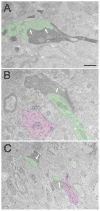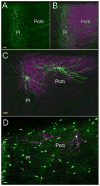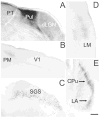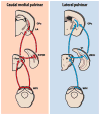The mouse pulvinar nucleus: Organization of the tectorecipient zones
- PMID: 28965504
- PMCID: PMC6050011
- DOI: 10.1017/S0952523817000050
The mouse pulvinar nucleus: Organization of the tectorecipient zones
Abstract
Comparative studies have greatly contributed to our understanding of the organization and function of visual pathways of the brain, including that of humans. This comparative approach is a particularly useful tactic for studying the pulvinar nucleus, an enigmatic structure which comprises the largest territory of the human thalamus. This review focuses on the regions of the mouse pulvinar that receive input from the superior colliculus, and highlights similarities of the tectorecipient pulvinar identified across species. Open questions are discussed, as well as the potential contributions of the mouse model for endeavors to elucidate the function of the pulvinar nucleus.
Keywords: Superior colliculus; Synapse; Thalamus; Visual.
Figures









References
-
- Abramson BP, Chalupa LM. The laminar distribution of cortical connections with the tecto- and cortico-recipient zones in the cat’s lateral posterior nucleus. Neuroscience. 1985;15:81–95. - PubMed
-
- Abramson BP, Chalupa LM. Multiple pathways from the superior colliculus to the extrageniculate visual thalamus of the cat. J Comp Neurol. 1988;271:397–418. - PubMed
Publication types
MeSH terms
Grants and funding
LinkOut - more resources
Full Text Sources
Other Literature Sources

